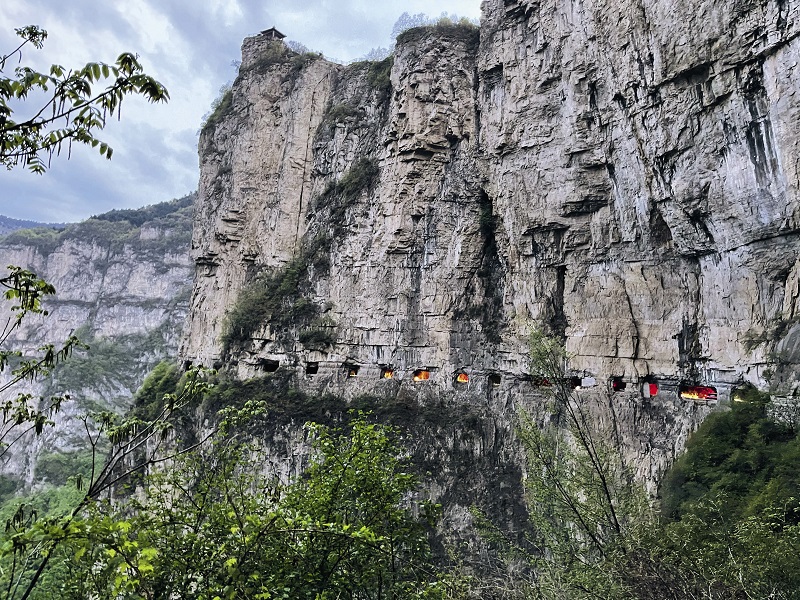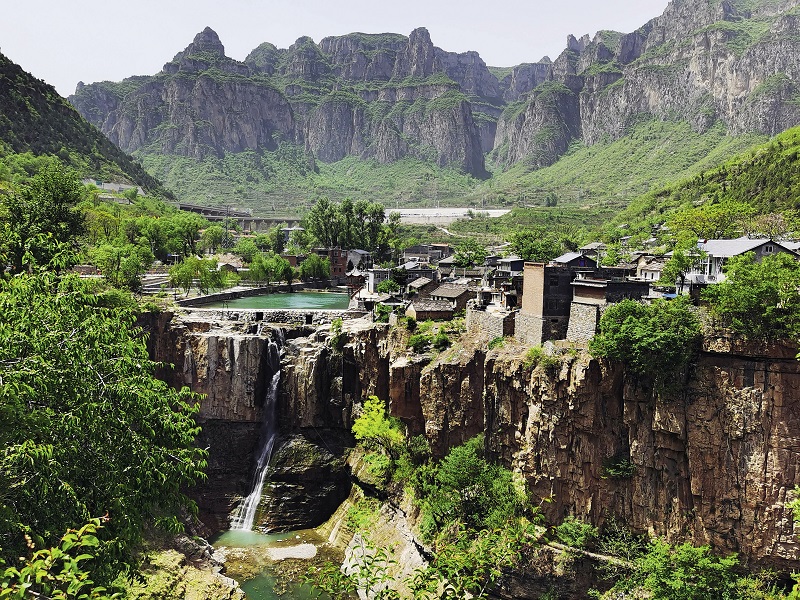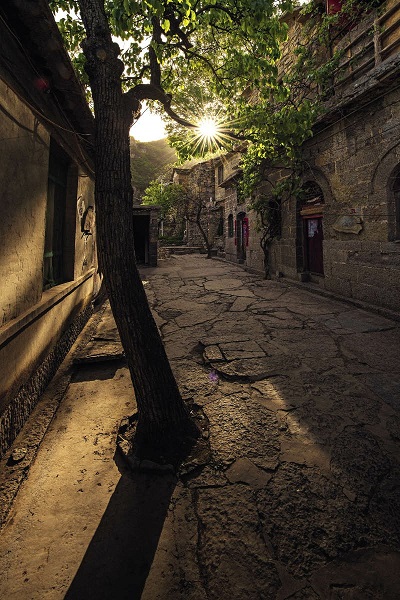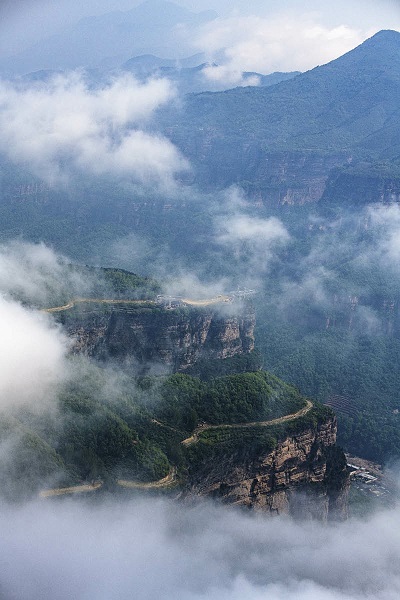With a minimum altitude of more than 1,200 meters above sea level, the mountain range is higher in the north and lower in the south, with some peaks reaching more than 2,000 meters above sea level. To the east of the mountain range is the North China Plain, while the Loess Plateau is in the west, thus creating a large dichotomy between the terrain on both sides. In the western region, the mountains are connected to high plateaus having a rather even topography, with gradual inclines and declines in the terrain, while the eastern region of the range is connected with the central plains, making the terrain quite uneven with many steep cliffs. These various geographical features add to the beauty of the Taihang Mountains scenery that can be described with words like magnificent, unique, dangerous, and serene.

A hanging cliff road carved right into the edge of a mountain is made visible by the rock windows on the side of the road.
Connecting Remote Villages with the World Beyond
The terrain in the eastern side of the Taihang Mountains is quite rugged, and many areas have rock faults, these geographical conditions have made it hard for locals to travel beyond their mountain villages.
The classical piece of ancient Taoist literature Lieh Tzu records a legend of an old man of the Northern Mountain. One day, as he set off on a journey from his village, he was stopped by the two major mountains of Taihang and Wangwu. He made up his mind at that moment that one day he would level those mountains to the ground. In response to disbelief of other people, he said, “When I die, my sons will carry on my work, and when they die, their sons will carry on their work to countless future generations. These mountains can’t get any higher, so with each piece we chisel away we are one step closer to flattening them.” This resolve of the old man deeply moved the celestial emperor who got two titans to move the two mountains. This classic Chinese legend is known as the “the foolish old man who removed the mountains.” Even though it is a legend, it demonstrates the characteristics of not being afraid of obstacles or setbacks and the determination to overcome difficulties and improve one’s living standard, which have become the basic features of the Taihang Mountains culture.
The building of the Red Flag Canal is a real modern version of the legendary story. Back in the 1960s, to cope with frequent droughts, the 300,000 residents of the Taihang Mountains used their hammers and shovels to open up 1,250 mountain peaks, erect 151 aqueducts, carve out 211 tunnels, and open up the 1,500-kilometer-long Red Flag Canal that stretches along the steep cliffs of the Taihang Mountains to direct river water into Linzhou County, and they did all of this in the space of 10 years. Linzhou has built over 400 reservoirs and ponds, and over 80 small and medium-sized hydropower stations, with an irrigation area of around 26,667 hectares. This has not only solved the problem of drinking water for people and livestock, but also provided water for industry.

The beautiful Hongni Village is built on top of a cliff.
The Hanging Cliff Roads
Living for thousands of years among the deep crisscrossing valleys of the Taihang Mountains full of rugged terrain, the local people have found pathways to reach beyond their valleys. There are eight roads that have been used to connect the three provinces in the region throughout history. But due to the steep cliffs, some remote places were shut away from the rest of the world for ages, and outsiders were unable to visit.
The Red Flag Canal greatly inspired the people of the Taihang Mountains to change their shut-in environment. Beginning in the 1970s, several generations were propelled by the belief that humans can conquer nature to improve their living environment. They overcame many difficulties and carved out a network of many tunnel roads through solid rock mountains. These public roads have become a part of the unique local landscape of the southern region of the mountain range, a rare scene in China.
In order to reduce the difficulties of the construction work and allow more natural light to shine onto the road, the cliff roads were carved close to the edge of the cliff and windows were drilled out of the rock every 10 meters. When viewed from a distance, the line of rock windows outline the direction of the tunnel. There are eight famous tunnel roads, four of which are almost works of art, namely the Guoliang Cliff Road, Xiyagou Cliff Road, Jingdi Cliff Road, and Hongtiguan Cliff Road.
These unique cliffside roads hanging within the deep reaches of the Taihang Mountains are attracting more and more tourists. Jingdi Cliff Road has turned the formerly secluded mountain ravine into a scenic attraction, drawing crowds of tourists every year. As a result, it brings the Jingdi Village millions of RMB in tourist revenue.
Because of the steepness of the cliffs, it is very difficult to build any other kind of road than these tunnel roads in the cliffs. Thanks to the hardworking spirit of the local people over the last several decades, the roads have continued to expand one meter at a time. According to the Yuejia Village chief, the village has been locked away in the mountains for more than 1,000 years. Villagers have toiled since the 1970s to build their own roads. After the year 2000, with the development of the Chinese economy, the government began to help build village roads. Village roads changed from rock to cement roads in 2009, expanding to three-meter-wide asphalt roads in 2019.
Today, with China’s progress in fighting against poverty, paved roads reach almost every village in the Taihang Mountains, making foot paths meandering up and down the mountains a thing of the past and the mountain region accessible to tourists.

Rays of sunlight light up an alley of Yuejia Village, Pingshun County, Shanxi Province.
Villages on Mountain Peaks
Various kinds of rock structures with different kinds of geomorphology have created countless steep mountain peaks and pristine lakes and rivers in the mountain region. Many tourist attractions have become famous such as the Baishi Mountain, Wutai Mountain, and Lingshan Mountain in the north, and Yuntai Mountain, Guoliang Village, and the Red Flag Canal in the south. As the infrastructure of the region gradually improves, more and more impressive scenery is becoming known to the public, especially in the southern region.
The south Taihang canyon crisscrosses back and forth through the mountains, and crustal movement has formed a lot of distinct fault-block rocks in many sections of the region, some as low as tens of meters, while others reaching heights of hundreds of meters, stretching tens of kilometers throughout the Taihang Mountains.
Zhangjiawa Village, located in a secluded gorge, is shrouded in mist, giving it the appearance of a scene from a fairytale. After a rain storm, a sea of clouds often forms in the valleys, making the peaks and rocks vaguely visible, giving it the appearance similar to that of the famous Zhangjiajie rock formation seen in the Hollywood movie Avatar. The difference here is that as the clouds gradually fade away, a series of roads appear looking like a ribbon, glistening in the light of the clouds, while the majestic Linzhou Grand Canyon appears below. Because painters often gather here, Zhangjiawa has been given the name “an artist village.” A sky walk is being built along the mountain, to give visitors a grand view of the scenery, and in the village, a number of farmhouses have also been built, equipped with all the basic furnishing for housing guests.
Since many villages in the Taihang Mountains are located near mountain faults, local people use rocks to build their homes and pave the roads. Yuejia Village is one of the villages that has preserved this rock culture. This village sits on the edge of a steep cliff and is often referred to as the “ Village in the Sky.”
According to the village chief, the decedents of Yue Fei, a famous general during the Southern Song Dynasty (1127–1279) took refuge in Yuejia Village. This village was surrounded by steep cliffs on all sides, making it easy to defend and difficult to attack. The area also has quality water. The roads were quite dangerous and rugged for some time, isolating the village from the outside world. Today, though the village is accessible by finely built roads, the village committee believes that preservation of the original traditional style of the village will attract more tourists, for this reason, the village has stipulated that all repairs or newly constructed buildings must continue the local tradition of building with stones. As a result, the entire village has stone houses, stone walls, stone tiles, stone streets, stone mills, stone grinding… turning the village into a world of stone.
Ancient trees, including more than 1,000-year-old areca palm trees, engulf the village during spring, maintaining a quaint and quiet environment; then in summer and autumn, the village is surrounded by pools and waterfalls, and wrapped in clouds and mist in the morning and evening. In 2012, Yuejia Village was added to the first batch of “Traditional Chinese Villages.” Over the past few years, even though the roads are still quite dangerous, many tourists have braved road conditions to visit the village. The two roads that lead in and out of the village are paved with asphalt and concrete, winding through green covered mountainsides, along the edges of steep cliffs, in full view of the canyon scenery. The village also provides accommodation to meet the needs of different tourists.

Winding roads can be seen through layers of clouds on the Taihang Mountains.
REN ZHAOXIA is a travel columnist.









